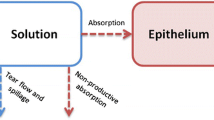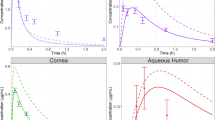Abstract
Introduction
Although the eye is directly accessible on the surface of the human body, drug delivery can be extremely challenging due to the presence of multiple protective barriers in eye tissues. Researchers have developed complex formulation strategies to overcome these barriers to ophthalmic drug delivery. Current development strategies rely heavily on in vitro experiments and animal testing to predict human pharmacokinetics (PK) and pharmacodynamics (PD).
Objective
The primary objective of the study was to develop a high-fidelity PK/PD model of the anterior eye for topical application of ophthalmic drug products.
Methods
Here, we present a physiologically-based in silico approach to predicting PK and PD in rabbits after topical administration of ophthalmic products. A first-principles based approach was used to describe timolol dissolution, transport, and distribution, including consideration of ionized transport, following topical instillation of a timolol suspension.
Results
Using literature transport and response parameters, the computational model described well the concentration–time and response-time profiles in rabbit. Comparison of validated rabbit model results and extrapolated human model results demonstrate observable differences in the distribution of timolol at multiple time points.
Conclusion
This modeling framework provides a tool for model-based prediction of PK in eye tissues and PD after topical ophthalmic drug administration to the eyes.














Similar content being viewed by others
References
Patel A, Cholkar K, Agrahari V, Mitra AK. Ocular drug delivery systems: An overview. World J Pharmacol. 2013;2(2):47–64.
Bourlais CL, Acar L, Zia H, Sado PA, Needham T, Leverge R. Ophthalmic drug delivery systems–recent advances. Prog Retin Eye Res. 1998;17(1):33–58.
Gulsen D, Chauhan A. Ophthalmic drug delivery through contact lenses. Invest Ophthalmol Vis Sci. 2004;45(7):2342–7.
Bachu RD, Chowdhury P, Al-Saedi ZHF, Karla PK, Boddu SHS. Ocular Drug Delivery Barriers—Role of Nanocarriers in the Treatment of Anterior Segment Ocular Diseases. Pharmaceutics [Internet]. 2018 Feb 27 [cited 2018 Apr 20];10(1). Available from: https://www.ncbi.nlm.nih.gov/pmc/articles/PMC5874841/.
Lang JC. Ocular drug delivery conventional ocular formulations. Adv Drug Deliv Rev. 1995;16(1):39–43.
Gaudana R, Ananthula HK, Parenky A, Mitra AK. Ocular drug delivery. AAPS J. 2010;12(3):348–60.
Agrahari V, Mandal A, Agrahari V, Trinh HM, Joseph M, Ray A, et al. A comprehensive insight on ocular pharmacokinetics. Drug Deliv Transl Res. 2016;6(6):735–54.
Worakul N, Robinson JR. Ocular pharmacokinetics/pharmacodynamics. Eur J Pharm Biopharm. 1997;44(1):71–83.
Bao Q, Newman B, Wang Y, Choi S, Burgess DJ. In vitro and ex vivo correlation of drug release from ophthalmic ointments. J Control Release Off J Control Release Soc. 2018;28(276):93–101.
Prantil-Baun R, Novak R, Das D, Somayaji MR, Przekwas A, Ingber DE. Physiologically Based Pharmacokinetic and Pharmacodynamic Analysis Enabled by Microfluidically Linked Organs-on-Chips. Annu Rev Pharmacol Toxicol. 2018;58(1):37–64.
Shen J, Burgess DJ. In vitro-in vivo correlation for complex non-oral drug products: Where do we stand? J Control Release Off J Control Release Soc. 2015;10(219):644–51.
Somayaji MR, Das D, Przekwas A. A new level a type IVIVC for the rational design of clinical trials toward regulatory approval of generic polymeric long-acting injectables. Clin Pharmacokinet. 2016;55(10):1179–90.
Zhang X, Zheng N, Lionberger RA, Yu LX. Innovative approaches for demonstration of bioequivalence: the US FDA perspective. Ther Deliv. 2013;4(6):725–40.
Balachandran RK, Barocas VH. Computer modeling of drug delivery to the posterior eye: effect of active transport and loss to choroidal blood flow. Pharm Res. 2008;25(11):2685–96.
Kavousanakis ME, Kalogeropoulos NG, Hatziavramidis DT. Computational modeling of drug delivery to the posterior eye. Chem Eng Sci. 2014;28(108):203–12.
Kotha S, Murtomäki L. Virtual pharmacokinetic model of human eye. Math Biosci. 2014;1(253):11–8.
Loke CY, Ooi EH, Salahudeen MS, Ramli N, Samsudin A. Segmental aqueous humour outflow and eye orientation have strong influence on ocular drug delivery. Appl Math Model. 2018;1(57):474–91.
Oh C, Saville BA, Cheng YL, Rootman DS. A compartmental model for the ocular pharmacokinetics of cyclosporine in rabbits. Pharm Res. 1995;12(3):433–7.
Park J, Bungay PM, Lutz RJ, Augsburger JJ, Millard RW, Sinha Roy A, et al. Evaluation of coupled convective-diffusive transport of drugs administered by intravitreal injection and controlled release implant. J Control Release Off J Control Release Soc. 2005;105(3):279–95.
Pinsky PM. Three-dimensional modeling of metabolic species transport in the cornea with a hydrogel intrastromal inlay. Invest Ophthalmol Vis Sci. 2014 Apr 8.
Shikamura Y, Ohtori A, Tojo K. Drug penetration of the posterior eye tissues after topical instillation: in vivo and in silico simulation. Chem Pharm Bull (Tokyo). 2011;59(10):1263–7.
Tojo K. A pharmacokinetic model for ocular drug delivery. Chem Pharm Bull (Tokyo). 2004;52(11):1290–4.
Avtar R, Tandon D. Modeling the drug transport in the anterior segment of the eye. Eur J Pharm Sci. 2008;35(3):175–82.
Deng F, Ranta VP, Kidron H, Urtti A. General pharmacokinetic model for topically administered ocular drug dosage forms. Pharm Res. 2016;33(11):2680–90.
Prausnitz MR, Noonan JS. Permeability of cornea, sclera, and conjunctiva: a literature analysis for drug delivery to the eye. J Pharm Sci. 1998;87(12):1479–88.
Pak J, Chen ZJ, Sun K, Przekwas A, Walenga R, Fan J. Computational modeling of drug transport across the in vitro cornea. Comput Biol Med. 2018;1(92):139–46.
Kannan R, Chen ZJ, Singh N, Przekwas A, Delvadia R, Tian G, et al. A quasi-3D wire approach to model pulmonary airflow in human airways. Int J Numer Methods Biomed Eng. 2017 Jul;33(7).
Przekwas A, Friend T, Teixeira R, Chen ZJ, Wilkerson P. Spatial modeling tools for cell biology [Internet]. CFD RESEARCH CORP HUNTSVILLE AL, CFD RESEARCH CORP HUNTSVILLE AL; 2006 Oct [cited 2018 May 3]. Available from: http://www.dtic.mil/docs/citations/ADA460852.
Kinsey VE, Reddy DVN. Chemistry and dynamics of aqueous humour. In: Prince JH, editor. The Rabbit Eye in Research. C.C. Thomas, Springfield; 1964. p. 218–319.
Patton NM. The biology of the laboratory rabbit. The Biology of the Laboratory Rabbit. 1994. 27–45 p.
Gupta C, Chauhan A, Mutharasan R, Srinivas SP. Measurement and modeling of diffusion kinetics of a lipophilic molecule across rabbit cornea. Pharm Res. 2010;27(4):699–711.
Missel PJ. Simulating intravitreal injections in anatomically accurate models for rabbit, monkey, and human eyes. Pharm Res. 2012;29(12):3251–72.
Brubaker RF, Nagataki S, Townsend DJ, Burns RR, Higgins RG, Wentworth W. The effect of age on aqueous humor formation in man. Ophthalmology. 1981;88(3):283–8.
Struble C, Howard S, Relph J. Comparison of ocular tissue weights ( volumes ) and tissue collection techniques in commonly used preclinical animal species mean male and female. 2014;2014.
Sawada T, Nakamura J, Nishida Y, Kani K, Morikawa S, Inubushi T. Magnetic resonance imaging studies of the volume of the rabbit eye with intravenous mannitol. 2002;25(3):173–7.
Ahmed I, Francoeur ML, Thombre AG, Patton TF. The Kinetics of Timolol in the Rabbit Lens: Implications for Ocular Drug Delivery. Pharm Res Off J Am Assoc Pharm Sci. 1989;6(9):772–8.
Zhang W, Prausnitz MR, Edwards AAA. Model of transient drug diffusion across cornea. J Control Release Off J Control Release Soc. 2004;99(2):241–58.
Francoeur ML, Sitek SJ, Costello B, Patton TF. Kinetic disposition and distribution of timolol in the rabbit eye. A physiologically based ocular model. Int J Pharm. 1985;25(3):275–92.
Henriksson JT, De Paiva C, Farley W, Pflugfelder S, Burns A, Bergmanson J. Morphologic alterations of the palpebral conjunctival epithelium in a dry eye model. Cornea. 2013;32(4):483–90.
Zhang X, Li Q, Xiang M, Zou H, Liu B, Zhou H, et al. Bulbar Conjunctival Thickness Measurements With Optical Coherence Tomography in Healthy Chinese Subjects. Invest Ophthalmol Vis Sci. 2013;54:4705–9.
Narayanaswamy A, Zheng C, Perera SA, Htoon HM, Friedman DS, Tun TA, et al. Variations in iris volume with physiologic mydriasis in subtypes of primary angle closure glaucoma. Invest Ophthalmol Vis Sci. 2013;54(1):708–13.
Baurmann M. Über die Entstehung von Scleralausbuchtungen unter dem Sehnerveneintritt an Kolobomaugen. Albrecht Von Graefes Arch Für Ophthalmol. 1923;112(3–4):495–505.
Chrai SS, Patton TF, Mehta A, Robinsonx JR. Lacrimal and Instilled Fluid Dynamics in Rabbit Eyes. J Pharm Sci. 1973;67(7):1112–21.
Avtar R, Tandon D. Mathematical Modelling of Intraretinal Oxygen Partial Pressure. Trop J Pharm Res. 2008;7(4):1107–16.
Prausnitz MR, Noonan JS. Permeability of cornea, sclera, and conjunctiva: A literature analysis for drug delivery to the eye. J Pharm Sci. 1998;87(12):1479–88.
Vareilles P, Silverstone D, Plazonnet B, Le Douarec JC, Sears ML, Stone CA. Comparison of the effects of timolol and other adrenergic agents on intraocular pressure in the rabbit. Invest Ophthalmol Vis Sci. 1977;16(11):987–96.
Huang HS, Schoenwald RD, Lach JL. Corneal penetration behavior of β-blocking agents: II - assessment of barrier contributions. J Pharm Sci. 1983;72(11):1272–9.
Sakanaka K, Kawazu K, Tomonari M, Kitahara T, Nakashima M, Nishida K, et al. Ocular pharmacokinetic/pharmacodynamic modeling for timolol in rabbits using a telemetry system. Biol Pharm Bull. 2008;31(5):970–5.
Goel M, Picciani RG, Lee RK, Bhattacharya SK. Aqueous humor dynamics: a review. Open Ophthalmol J. 2010;4:52–9.
Sonntag JR, Brindley GO, Shields MB. Effect of timolol therapy on outflow facility. Invest Ophthalmol Vis Sci. 1978;17(3):293–6.
Coakes RL, Brubaker RF. The mechanism of timolol in lowering intraocular pressure: in the normal eye. Arch Ophthalmol. 1978;96(11):2045–8.
Kinsey V, Reddy D. Chemistry and dynamics of aqueous humor. in: the rabbit in eye research. Springfield, IL: CC Thomas; 1964. p. 218–319. (Chemistry and dynamics of aqueous humor).
Ahmed I, Patton TF. Disposition of timolol and inulin in the rabbit eye following corneal versus non-corneal absorption. Int J Pharm. 1987;38(1):9–21.
Adams BM, Ebeida MS, Eldred MS, Jakeman JD, Swiler LP, Stephens JA, et al. DAKOTA, A multilevel parallel object-oriented framework for design optimization, parameter estimation, uncertainty quantification, and sensitivity analysis: version 6.3 User’s Manual. Sandia Technical Report SAND2014–4633; 2015.
Lee VHL, Luo AM, Li S, Podder SK, Chang JSC, Ohdo S, et al. Pharmacokinetic basis for nonadditivity of intraocular pressure lowering in timolol combinations. Invest Ophthalmol Vis Sci. 1991;32(11):2948–57.
Ahmed I, Patton TF. Disposition of timolol and inulin in the rabbit eye following corneal versus non-corneal absorption. Int J Pharm. 1987;38(1–3):9–21.
Gwon A, Tsonis P, Gwon A. Animal Models in Eye Research. 1st ed. Animal models in eye research. San Diego, Ca: Elsevier; 2008. 184–204 p.
Narayanaswamy A, Zheng C, Perera SA, Htoon HM, Friedman DS, Tun TA, et al. Variations in iris volume with physiologic mydriasis in subtypes of primary angle closure glaucoma. Invest Ophthalmol Vis Sci. 2013;54(1):708–13.
Struble C, Howard S, Relph J. Comparison of ocular tissue weights (volumes) and tissue collection techniques in commonly used preclinical animal species. Acta Ophthalmol (Copenh). 2014 Aug 20;92(s253):0–0.
Acknowledgements
We would like to thank Dr. Kay Sun and Mr. Joseph Pak for their early contributions to the project.
Funding
This project was supported by the Food and Drug Administration (FDA) of the U.S. Department of Health and Human Services (HHS) as part of two financial assistance awards [U01FD005219 and HHSF223201810151C] totaling $453,423 and $499,806 with 100 percent funded by FDA/HHS. The contents are those of the author(s) and do not necessarily represent the official views of, nor an endorsement, by FDA/HHS, or the U.S. Government.
Author information
Authors and Affiliations
Corresponding author
Ethics declarations
Conflict of Interest
The opinions expressed in the manuscript are those of the authors and should not be interpreted as the position of the US Food and Drug Administration. All authors declared no conflict of interest.
Additional information
Publisher's Note
Springer Nature remains neutral with regard to jurisdictional claims in published maps and institutional affiliations.
Supplementary Information
Below is the link to the electronic supplementary material.
Rights and permissions
Springer Nature or its licensor (e.g. a society or other partner) holds exclusive rights to this article under a publishing agreement with the author(s) or other rightsholder(s); author self-archiving of the accepted manuscript version of this article is solely governed by the terms of such publishing agreement and applicable law.
About this article
Cite this article
German, C., Chen, Z., Przekwas, A. et al. Computational Model of In Vivo Corneal Pharmacokinetics and Pharmacodynamics of Topically Administered Ophthalmic Drug Products. Pharm Res 40, 961–975 (2023). https://doi.org/10.1007/s11095-023-03480-6
Received:
Accepted:
Published:
Issue Date:
DOI: https://doi.org/10.1007/s11095-023-03480-6




